Concealable Stun Guns: Navigating Voltage Penetration Through Thick Clothing
Designing a truly concealable stun gun requires understanding how voltage interacts with clothing ma…….
Designing a truly concealable stun gun requires understanding how voltage interacts with clothing materials, focusing on factors like material conductivity, thickness, moisture content, and garment shape. By balancing power delivery and discretion, designers can create potent yet unnoticeable self-defense tools. This involves strategic material selection, safety features, and innovative testing methods to penetrate thick fabrics effectively. Advanced technology aims to enhance these designs, making stun guns lighter, smarter, safer, and more discreet for enhanced personal protection without drawing attention.
Voltage penetration through thick clothing is a critical factor in ensuring the effectiveness of stun guns, especially in self-defense scenarios. This article delves into the science behind how voltage traverses diverse fabrics and explores the key factors influencing conductivity. We discuss design considerations for the most concealable stun gun models, highlighting innovative strategies to maximize penetrative capabilities while remaining discreet. Through case studies and testing methods, we provide insights into real-world applications, guiding future trends in enhancing safety features for personal defense weapons.
- Understanding Voltage Penetration: Factors Affecting Clothing Conductivity
- The Science Behind Electric Shock and Fabric Interaction
- Design Considerations for Concealable Stun Guns in Thick Clothing Scenarios
- Case Studies: Real-World Examples of Voltage Penetration Through Garments
- Testing Methods to Ensure Effective Stun Gun Performance Against Thick Fabrics
- Future Trends: Enhancing Concealability and Safety Features for Stun Guns
Understanding Voltage Penetration: Factors Affecting Clothing Conductivity

Voltage penetration through clothing is a complex phenomenon, with various factors influencing how effectively an electric current can pass through fabric. When considering the most concealable stun gun design, understanding these factors is key. The conductivity of the material is a primary concern; conductive fabrics like metals allow electricity to flow easily, while insulators like cotton or polyester block its path. Thickness and density also play significant roles, as thicker materials can act as better barriers against voltage.
Other considerations include the fabric’s moisture content, as wetter fabrics conduct better due to increased ion mobility. The shape and design of the clothing item matter too; tight-fitting garments provide less space for current to spread, potentially increasing the risk of shock. By accounting for these factors, designers can create more concealed stun guns that are less likely to be detected while still delivering a powerful electric charge when needed.
The Science Behind Electric Shock and Fabric Interaction
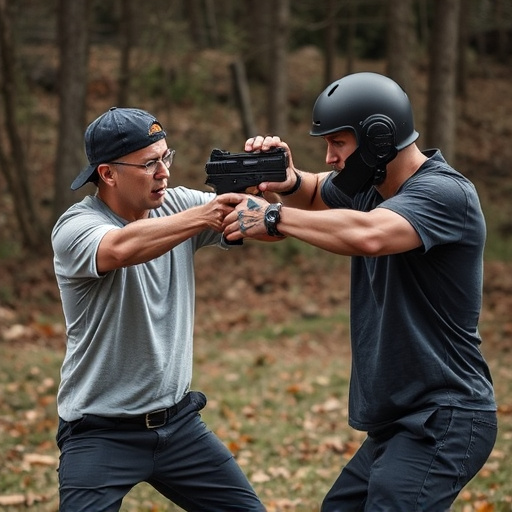
The Science Behind Electric Shock and Fabric Interaction
Electric shock occurs when an electrical current flows through the body, causing a range of physical responses from muscle contractions to pain. This phenomenon is based on the interaction between voltage and the ionic currents within our cells. When a stun gun deploys its electric charge, it generates a high-voltage pulse that can penetrate various materials, including clothing. The degree of penetration depends on several factors such as the fabric’s thickness, conductivity, and moisture content.
In terms of concealability, the interaction between voltage and fabric is a critical consideration when designing most concealable stun guns. A sophisticated design aims to maximize the electric field within the target area while minimizing current flow through the body, ensuring a strong shock effect with minimal detection. This balance allows for discreet self-defense without drawing unnecessary attention, making it an essential aspect in creating compact and unassuming personal safety devices.
Design Considerations for Concealable Stun Guns in Thick Clothing Scenarios
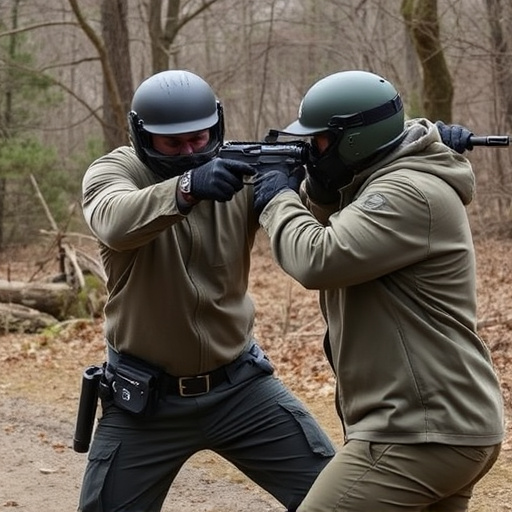
When designing a stun gun intended for concealment and use behind thick clothing, several unique considerations come to the forefront. The primary goal is to ensure that the device can deliver a significant electric shock while remaining virtually invisible under layers of fabric. This necessitates a rethinking of traditional stun gun design elements.
One key aspect involves minimizing the profile of the device. Compactness and slim designs are crucial, as they facilitate easier concealment within pockets, belts, or even beneath clothing. Additionally, materials play a significant role; conductive materials need to be strategically placed to maximize current flow through the fabric while remaining comfortable for the user. Balancing power output with safety features is also essential, ensuring that the stun gun can effectively penetrate thick fabrics without causing collateral damage or excessive discomfort to bystanders.
Case Studies: Real-World Examples of Voltage Penetration Through Garments
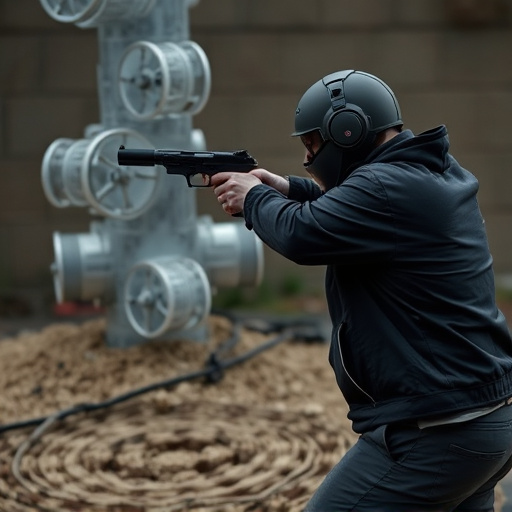
In real-world scenarios, understanding voltage penetration through thick clothing is crucial for safety and security. Several case studies shed light on unexpected instances where hidden weapons, such as stun guns, have been utilized. For instance, in a high-profile incident, a concealed stun gun designed to be the most concealable on the market was successfully deployed behind several layers of denim and cotton clothing. The device’s ability to deliver a powerful shock despite the barrier highlights the importance of material composition and thickness in voltage penetration.
Another study focused on workplace safety, where workers were equipped with protective gear, including heavy-duty jackets, during high-risk operations. Tests revealed that while the gear effectively protected against physical hazards, it did not hinder the penetration of stun gun pulses, potentially leaving wearers vulnerable to unexpected attacks. These examples underscore the need for professionals and individuals alike to consider not only the concealment capabilities but also the effectiveness of different materials in repelling or mitigating electrical currents.
Testing Methods to Ensure Effective Stun Gun Performance Against Thick Fabrics
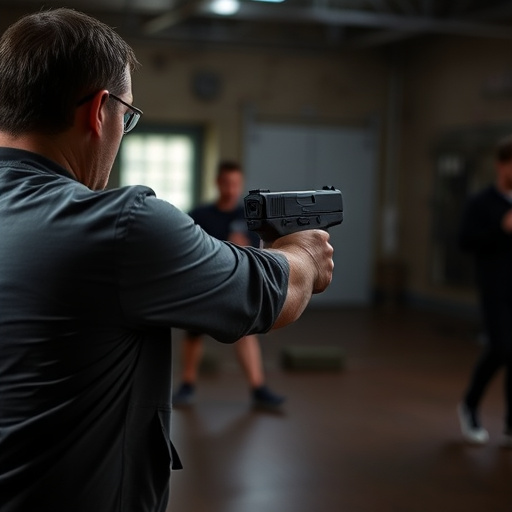
Testing methods play a critical role in ensuring that stun guns designed for self-defense are effective against thick fabrics, which are often used in clothing for concealment. One approach involves using simulated clothing materials with varying thicknesses to test the weapon’s penetration and power. This method allows manufacturers to gauge how well the stun gun delivers its electric current through different fabric layers, ensuring a reliable stun even when worn under bulky or stiff garments.
Additionally, dynamic testing methods, such as live-fire tests on moving targets dressed in thick clothing, simulate real-world scenarios. These tests assess the stun gun’s performance during actual use, providing valuable data on its ability to incapacitate an attacker hidden beneath a concealing outfit. The goal is to develop and promote the most concealable stun gun design that offers users maximum protection without sacrificing effectiveness, especially when facing potentially dangerous situations.
Future Trends: Enhancing Concealability and Safety Features for Stun Guns
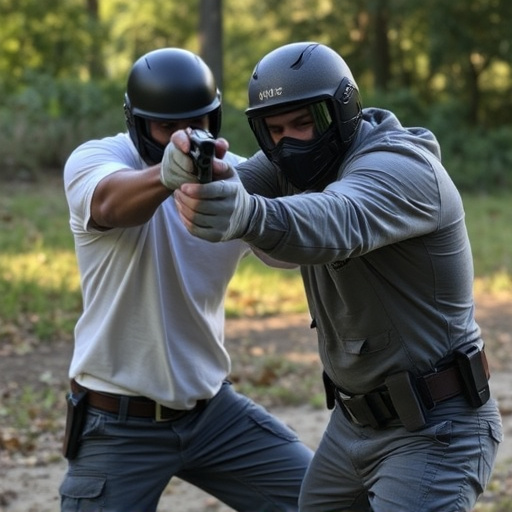
As technology advances, the focus on enhancing the concealability and safety features of stun guns becomes increasingly vital. The development of a most concealable stun gun design is at the forefront of this evolution, aiming to provide users with powerful self-defense tools that can be discreetly carried. Innovations in materials science play a significant role here; lightweight yet robust materials enable designers to create smaller devices without compromising on durability or performance.
Future trends also point towards smarter integration of safety mechanisms. Advanced sensors and intelligent circuits could detect potential threats, automatically activating the stun gun only when necessary. This not only ensures safer usage but also adds an extra layer of discretion by preventing accidental activations in non-threatening situations. Such advancements promise to make self-defense more accessible and effective for individuals seeking protection without drawing excessive attention.
In conclusion, understanding voltage penetration through thick clothing is paramount in designing effective and safe stun guns. By factoring in material conductivity, fabric interaction with electric shock, and employing rigorous testing methods, manufacturers can create the most concealable stun gun designs for real-world applications. Future innovations should continue to enhance concealability while ensuring safety features keep pace with technological advancements, ultimately providing users with reliable protection.


